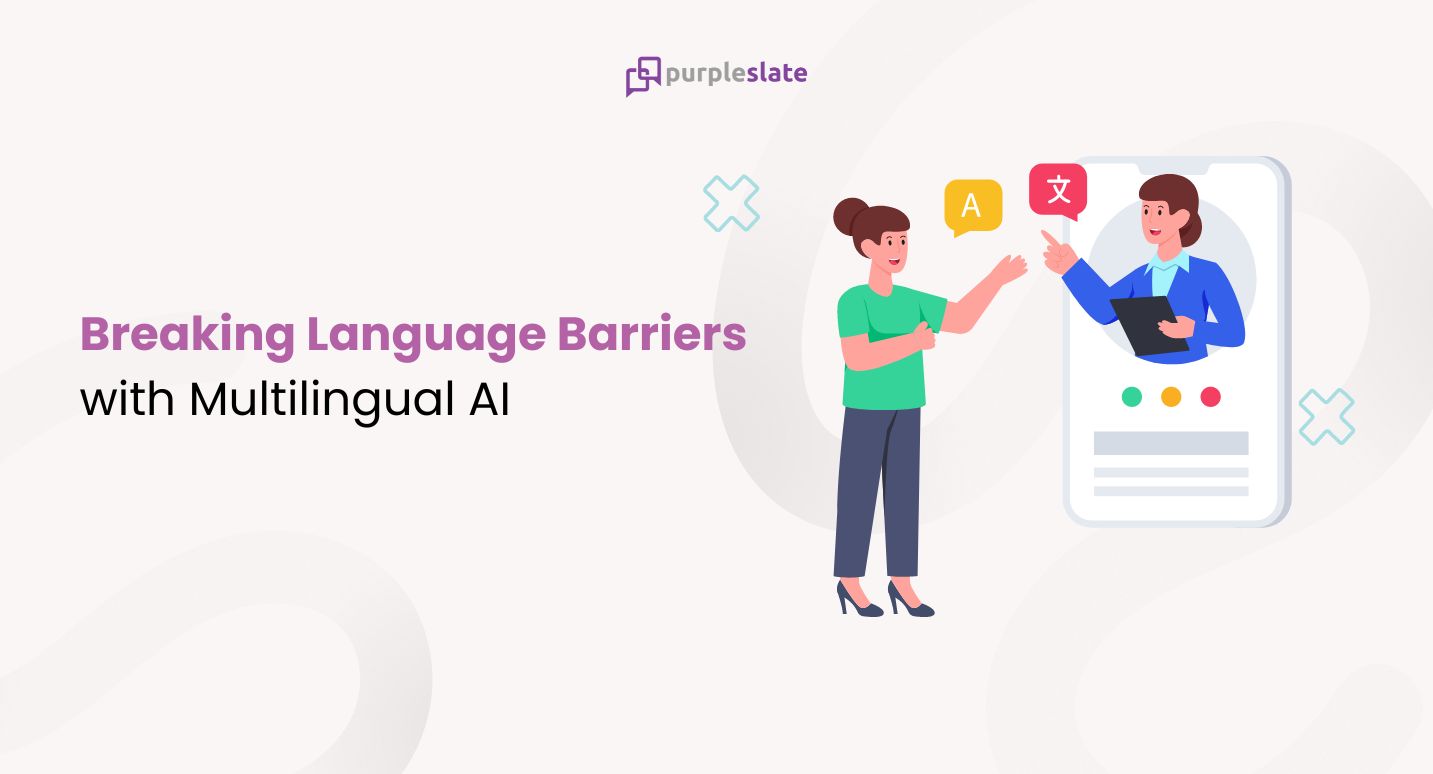
Introduction
Accessing insurance services can be a complex task, but for non-native speakers, it often becomes a daunting challenge. Understanding policy details, filing claims, or simply asking questions becomes frustrating when the available information is in an unfamiliar language. This communication barrier not only alienates a large portion of potential customers but also increases the risk of miscommunication, leading to inadequate coverage or misinformed decisions.
As insurance becomes a necessity for financial security, it’s crucial that services be accessible to everyone, regardless of their language proficiency. Yet, traditional customer service channels often fall short, offering limited language support or relying on translation services that fail to capture nuances.
Multilingual AI is bridging this gap, allowing insurance providers to offer seamless, personalized support in multiple languages. By breaking down these language barriers, insurers can reach a wider audience, enhance trust, and ensure that everyone, regardless of language, has equal access to the coverage they need.
Challenges with Language Accessibility in Insurance
Insurance policies can be complex, but the challenge is even greater when language barriers come into play. Here are some key issues faced by non-native speakers:
Understanding Policy Terminology: Insurance terms, such as deductibles, premiums, and exclusions, are hard enough to understand in a native language. For non-native speakers, these terms become roadblocks, leading to confusion about coverage and benefits.
Limited Multilingual Resources: Many insurance companies provide information only in major languages, like English or Spanish, which excludes customers who speak less common languages. This lack of support can leave entire communities underserved or relying on poorly translated documents that may lead to misinterpretations.
Ineffective Customer Service: Even when language support exists, it often depends on translators or bilingual agents who may not be available 24/7. This leaves non-native speakers struggling to access immediate assistance when they need it most, whether it’s for filing claims or seeking advice on policy renewals.
Addressing language accessibility is not just a matter of convenience—it’s essential for creating an inclusive insurance system where all customers can confidently make informed decisions about their coverage.
Multilingual AI: A Game Changer for Insurance Providers
Multilingual AI technology revolutionizes how insurers interact with their customers by enabling seamless communication in multiple languages. Here’s how it changes the game:
Instant, Accurate Translation: Multilingual AI enables real-time translation, ensuring that customers receive accurate information in their preferred language. Unlike traditional translation methods that may take time and sometimes lose meaning, AI-driven systems provide instant, reliable translations that adapt to the context of the conversation.
Improving Cultural Sensitivity: Beyond language, Multilingual AI can interpret cultural nuances, which helps avoid communication breakdowns that stem from cultural misunderstandings. Insurance policies often have legal and cultural components and communicating these nuances effectively builds trust between insurers and customers.
Supporting Global Expansion: As insurance companies expand into new markets, they face the challenge of providing consistent service across regions with different languages. Multilingual AI allows insurers to deliver standardized, high-quality customer support across borders, ensuring consistency in policy explanations, claims processes, and customer care.
Round-the-Clock Support: AI-driven systems work 24/7, allowing customers to engage in their native language at any time, without waiting for human translators or bilingual agents. This round-the-clock service boosts customer satisfaction and ensures that language is never a barrier to accessing insurance services.
This technology offers a scalable, cost-effective solution that allows insurers to provide personalized, language-friendly services to diverse customer bases, ensuring that language is no longer a barrier to high-quality service.
Enhancing Customer Experience with Real-Time Language Support
Multilingual AI provides insurers with the ability to deliver real-time, personalized support in multiple languages. Here’s how this capability enhances the overall customer experience:
Instant Responses in Preferred Language: Customers can communicate with AI-driven systems in their preferred language and receive immediate, accurate responses. This is particularly helpful for non-native speakers who may struggle with the intricacies of insurance jargon in a second language.
Tailored Conversations Based on Context: Multilingual AI doesn’t just translate words; it understands the context of the conversation. This means customers aren’t left frustrated by literal, out-of-context translations that miss the point of their questions. The AI adapts to the flow of the conversation, providing meaningful responses that feel natural.
Simplified Claims and Policy Updates: Filing claims or updating policies can be a hassle, especially when language barriers exist. Multilingual AI guides customers through these processes with step-by-step instructions, ensuring they understand every part of the interaction. The ease of communication reduces the stress of complex procedures.
Increased Trust and Loyalty: When customers feel understood and valued, they’re more likely to stay loyal to their insurance providers. By offering personalized interactions in their native languages, insurers can build stronger relationships and earn long-term trust.
Democratizing Insurance Access: Reaching Underserved Communities
Multilingual AI is playing a vital role in reaching underserved communities who have traditionally been excluded from comprehensive insurance services due to language barriers. This inclusivity is crucial for expanding access and ensuring that more individuals can benefit from the protection that insurance provides. Here’s how Multilingual AI helps democratize access:
Bridging the Language Divide: Many underserved communities speak minority languages that are not typically supported by traditional insurance platforms. Multilingual AI empowers insurers to communicate effectively with these populations, ensuring that they can access the same level of service and protection as those who speak more widely recognized languages.
Improving Financial Literacy: In many cases, a lack of understanding about insurance concepts prevents people from seeking coverage. Multilingual AI can simplify insurance language and terminology, making it easier for individuals to comprehend policy terms, compare options, and make informed decisions. This fosters financial literacy among customers who were previously excluded from the conversation.
Building Trust with Diverse Communities: By offering services in native languages, insurers can build a deeper sense of trust with communities that may have been skeptical of insurance services due to past experiences with miscommunication or confusion. Multilingual AI helps eliminate this distrust by providing transparent, understandable service.
Expanding Market Reach: Insurance providers can expand their customer base by reaching untapped markets where language barriers have previously been a deterrent. Multilingual AI makes it easier to enter new regions and build connections with customers who have been overlooked by traditional methods.
By reaching these communities, insurers not only fulfill their social responsibility but also open new opportunities for business growth.
Reducing Errors and Miscommunication
When it comes to insurance, even a small misunderstanding can lead to significant consequences—whether it’s a missed coverage detail or an incorrectly filed claim. Here’s how Multilingual AI reduces errors and improves communication between insurers and their customers:
Accurate Policy Explanations: Multilingual AI ensures that complex insurance terms and conditions are communicated clearly, reducing the risk of customers misunderstanding their coverage. By providing accurate translations, AI helps prevent costly errors, such as a customer believing they’re covered for something when they’re not.
Fewer Misfiled Claims: Filing insurance claims can be confusing, especially when there’s a language barrier. Multilingual AI simplifies the claims process by guiding customers through each step in their native language, ensuring that they provide the correct information and file their claims properly.
Improved Customer Support Consistency: With human agents, there’s always the risk of inconsistencies in service quality, especially when dealing with multiple languages. Multilingual AI provides consistent, high-quality support in any language, ensuring that all customers receive the same level of service, regardless of their linguistic background.
Reduced Legal and Regulatory Risks: Miscommunication around insurance policies can sometimes lead to legal disputes or regulatory challenges. By providing clear, understandable information, Multilingual AI reduces the risk of misinterpretation, helping insurers avoid costly legal issues.
This enhanced clarity and accuracy improved the customer experience and protected insurers from unnecessary complications.
The Role of Multilingual AI in Global Insurance Expansion
As insurance providers look to expand into global markets, language is one of the key challenges they face. Here’s how Multilingual AI supports global expansion strategies:
Seamless Cross-Border Communication: Insurers can provide seamless communication across regions with different languages, ensuring that customers in new markets receive the same high-quality service as those in established regions. This is essential for maintaining brand consistency and customer trust across multiple countries.
Localized Customer Service: Multilingual AI adapts not only to different languages but also to regional dialects and cultural nuances. This localization ensures that customers feel understood and valued, no matter where they’re from.
Efficient Onboarding for International Customers: Multilingual AI simplifies the process of onboarding new customers by offering personalized, step-by-step guidance in their native language. This helps reduce friction during the initial sign-up process, making it easier for insurers to acquire customers in new regions.
Cost-Effective Global Scaling: Expanding into international markets typically requires a large investment in human resources, such as hiring multilingual agents. With AI-driven language solutions, insurers can scale their operations globally without significantly increasing overhead costs, making it easier to grow their business across borders.
In short, Multilingual AI enables insurers to expand globally while maintaining the personalized, responsive customer service that customers expect.
Conclusion: Embracing Multilingual AI for an Inclusive Insurance Future
As the insurance landscape continues to evolve, the need for personalized, language-friendly services has become more critical than ever. Multilingual AI offers a transformative solution, breaking down language barriers that have traditionally excluded large segments of the population from accessing essential insurance services. By providing real-time, accurate translations, understanding cultural contexts, and ensuring consistent communication across regions, Multilingual AI is democratizing access to insurance, helping insurers serve diverse communities more effectively.
At purpleSlate, we are dedicated to helping insurance providers leverage the full potential of Multilingual AI. Our AI-driven conversational solutions are designed to offer seamless, personalized interactions that adapt to the linguistic and cultural needs of each customer. With PurpleSlate, insurers can not only improve customer engagement but also expand their market reach and deliver high-quality service to previously underserved communities. In doing so, insurers are not just staying competitive—they are building a more inclusive, accessible future for the global insurance industry.




